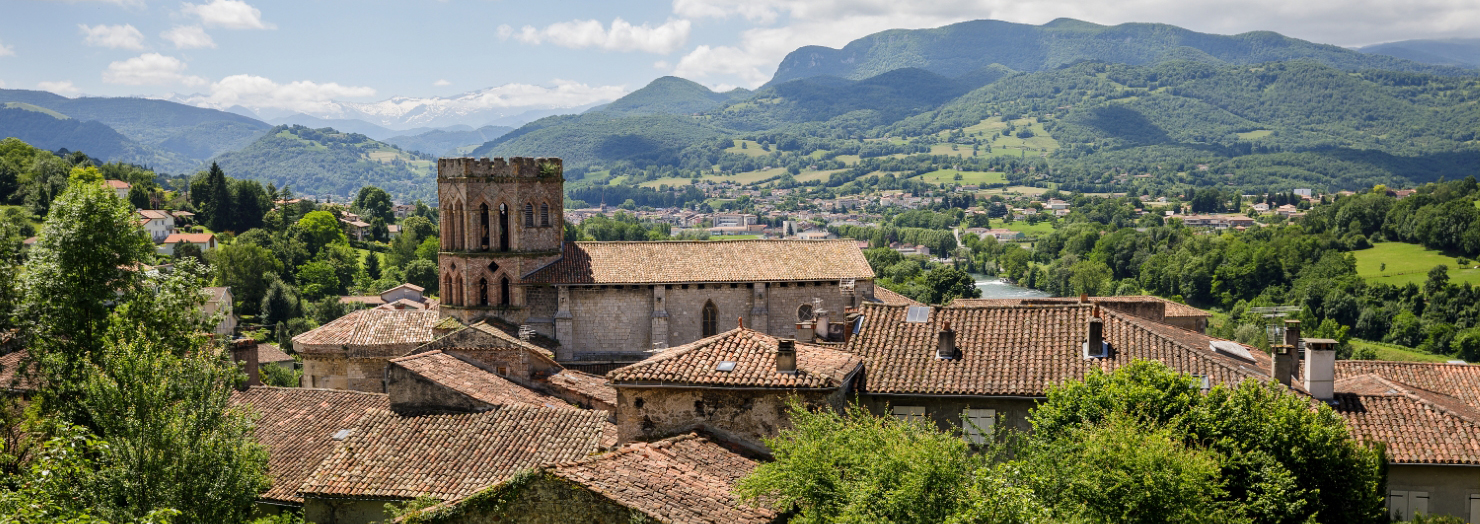The GR78 Pyrenean Piedmont route is the most southerly of the routes to Santiago de Compostela. It passes through such treasures as our cultural heritage sites of Carcassonne, Mirepoix, Saint-Bertrand de Comminges, Lourdes, Roncevaux, or even our beautiful town of Saint-Lizier.

As soon as spring arrives, we can already see the pilgrims on the GR78, sporting backpacks and rain ponchos, proudly displaying the great scallop around their neck or embroidered on their staff.
It is on the Via Tolosana variant in the heart of the Occitan region, and from Narbonne onwards, that the Pyrenean Piedmont route begins. Past Carcassonne and Fanjeaux, the ridge paths open onto the Pyrenees just a short distance from the town of Foix, before the Ariège Pyrenees Nature Park opens its arms.

- Distance : 520 km (approx. 340 km in Midi-Pyrénées)
- Duration : 30 days of walking (about 15 days in the Midi-Pyrénées)
- Markings : white/red
- Altitude : from 100 to 1,207 m
- Recommended period : from April to October.
- Reference FFRP Topoguide : “Le Chemin du piémont pyrénéen vers Saint-Jacques de Compostelle” (“The Pyrenean Piedmont Way to Santiago de Compostela”)
- Pilgrims’ accommodation/stopovers :

Once upon a time, there were two German pilgrims – a father and a son – who, in the year 1090, on their way to the tomb of St James, arrived in Santo Domingo de la Calzada with a lot of money and stayed with a rich innkeeper. This villain, who pretended to be a gentle lamb with his pleasant appearance, welcomed them with concern and, under the guise of hospitality, treacherously encouraged them to get drunk by serving them various drinks. While the pilgrims slept a sleep still weighed down by drunkenness, the dishonest host, driven by the spirit of greed, secretly hid a silver cup in one of the sleepers’ bags, in order to frame them for theft and steal their savings. The next day, as they left after the cock’s crow, the host pursued them with an armed troop, yelling : “Give it back, give me back the money you stole from me ! ”». They answered him : “ If you find anything on either of us, you’ll just have to convict him. ”»
To find out what happens next, head to the Saint Pierre Chapel in Castillon-en-Couserans. To the right of the small Romanesque window, a painting tells the story. That of the “Hungman Unhung” (or “Pendu-Dépendu”), a legend that has been told along the roads to Compostela since the 12th century …
The progression towards the west leads to the succesive discoveries of the masterpiece of the heritage of the Haut-Garonnais, the ancient Roman city of Saint-Bertrand de Comminges, a shrine of 2000 years of art and history, the thermal springs of Bagnères de Bigorre, the cave of Lourdes, Mauléon, and Saint-Jean-Pied-de-Port – the gateway towards the Spanish Camino de Santiago.
 Local and gastronomic know-how
Local and gastronomic know-how  Living traditions
Living traditions  Thermalism
Thermalism  Must-see sights
Must-see sights  In the heart of the Ariège Pyrenees Regional Nature Park
In the heart of the Ariège Pyrenees Regional Nature Park  Hiking in the Couserans
Hiking in the Couserans  Cycling and mountain biking
Cycling and mountain biking  Hikes for little legs
Hikes for little legs  Thrills
Thrills  We have plenty of good runs in Guzet !
We have plenty of good runs in Guzet !  Swimming spots
Swimming spots  The Couserans Trail-Biking Area
The Couserans Trail-Biking Area  Winter resorts and activities
Winter resorts and activities  Where to sleep ?
Where to sleep ?  Where to eat ?
Where to eat ?  To do ?
To do ? 











